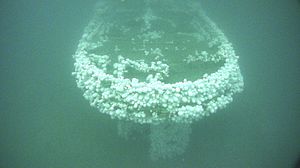USS Conestoga (AT-54) facts for kids

Conestoga in 1921
|
|
| History | |
|---|---|
| Name | USS Conestoga |
| Builder | Maryland Steel Company, Sparrows Point, Maryland, U.S. |
| Laid down | 1904 |
| Acquired | by purchase, 14 September 1917 |
| Commissioned | 10 November 1917 |
| Reclassified | AT-54, 17 July 1920 |
| Fate | Declared lost with all her crew, 30 June 1921 [wreck found 2016] |
| General characteristics | |
| Type | Tugboat |
| Displacement | 420 long tons (430 t) |
| Length | 170 ft (52 m) |
| Beam | 29 ft (8.8 m) |
| Draft | 15 ft (4.6 m) |
| Speed | 13 kn (15 mph; 24 km/h) |
| Complement | 56 |
| Armament | 1 × 3 in (76 mm) gun |
|
USS Conestoga (shipwreck and remains)
|
|
| Lua error in Module:Location_map at line 420: attempt to index field 'wikibase' (a nil value). | |
| Location | Atlantic Ocean |
| Nearest city | San Francisco, California |
| Built | 1903 |
| Architect | Maryland Steel Company |
| NRHP reference No. | 16000358 |
| Added to NRHP | October 6, 2016 |
The USS Conestoga was a powerful tugboat that served in the United States Navy. It was built in 1904 and joined the Navy in 1917. This ship became famous because it mysteriously disappeared in the Pacific Ocean in 1921. For many years, no one knew what happened to it. The mystery was finally solved in 2016 when its sunken remains were found and identified.
Contents
Building the Conestoga
The Conestoga was first built as a tugboat for a railway company called the Philadelphia and Reading Railway. It was constructed in 1904 by the Maryland Steel Company in Sparrows Point, Maryland.
The United States Navy bought the Conestoga on September 14, 1917. This was during World War I, and the Navy needed more ships. It was given the Navy number SP-1128. The ship officially joined the Navy on November 10, 1917. Lieutenant (junior grade) C. Olsen was its first commander.
Conestoga at Work
The Conestoga was assigned to the Navy's Submarine Force. Its main job was to tow other ships along the Atlantic coast. It also carried important supplies and guns.
The tugboat helped escort groups of ships, called convoys, to places like Bermuda and the Azores. It also patrolled the waters around the Azores. After World War I ended, the Conestoga stayed near the Azores. It continued to tow damaged ships and escort convoys.
On September 26, 1919, the Conestoga returned to New York. It was then sent to Norfolk, Virginia, to work as a harbor tug. In July 1920, the ship received a new hull number, AT-54.
The Mystery of Its Disappearance
In late 1920, the Conestoga moved to the Pacific Ocean. It spent the first three months of 1921 in San Diego, California and Mare Island, California.
On March 25, 1921, the tugboat left Mare Island. It was carrying a barge full of coal. Its mission was to sail to Tutuila, American Samoa, via Pearl Harbor. There, it would serve as a station ship.
Lieutenant Ernest Larkin Jones was the commander of the Conestoga at this time. After leaving Mare Island, no one ever heard from the Conestoga again. A large search was launched, but they found very little. The only clue was a lifeboat with the letter "C" on it. This lifeboat was found near Manzanillo, Mexico. The ship and its entire crew of 56 sailors were lost.
Finding the Wreck
The wreck of the Conestoga was first found in 2009. It was discovered in the Greater Farallones National Marine Sanctuary. This area is just a few miles from Southeast Farallon Island, off the coast of San Francisco, California. At the time, no one knew what ship it was.
In October 2015, a team from the NOAA and the Navy worked together. They confirmed that the shipwreck was indeed the Conestoga. On March 23, 2016, 95 years after the ship disappeared, the official announcement was made. The shipwreck was added to the National Register of Historic Places in 2016. This means it is an important historical site.



